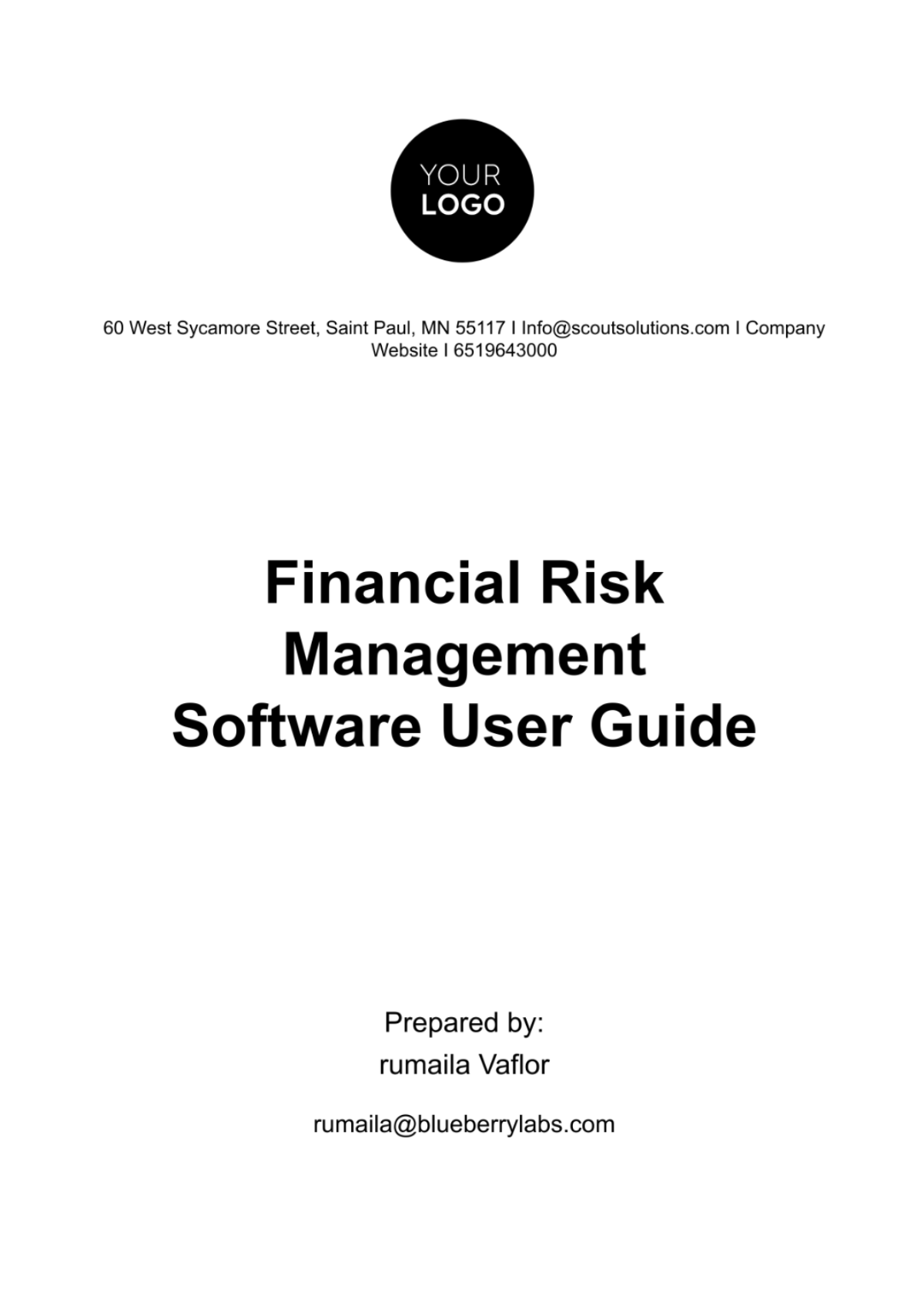Free Financial Risk Management Software User Guide

Table of Contents
Introduction
System Requirements
Installation and Setup
User Registration and Login
Dashboard and User Interface Overview
Risk Management Tools and Features
Data Management and Integration
Reporting and Analytics
Troubleshooting and Support
Legal and Compliance Information
A. Introduction
This user guide provides an exhaustive look at the functionalities of our Financial Risk Management Software. It is intended to help users navigate and utilize the software features for the effective management of market, credit, operational, and liquidity risks.
This software is a robust tool designed to help you identify, assess, and manage financial risks effectively and efficiently. The user guide outlines how to use the software, offers solutions to possible challenges, and provides information on how to leverage its capacity to the maximum.
B. System Requirements
This section outlines the necessary system specifications to ensure that the Financial Risk Management Software runs efficiently and effectively. Adhering to these requirements is crucial for optimal performance and functionality of the tool.
a. Hardware Requirements
Processor: Minimum Intel Core i5 or equivalent; Recommended i7 or higher.
Memory: Minimum 8 GB RAM; Recommended 16 GB or more.
Hard Disk: At least 20 GB of free space; SSD preferred for faster data processing.
Display: 1080p resolution; recommended dual monitor setup for extensive data analysis.
b. Software Requirements
Operating System: Windows 10 or later, MacOS 10.14 or later.
Browser Compatibility: Latest versions of Chrome, Firefox, Safari, or Edge.
Database Compatibility: SQL Server 2016, Oracle 12c, or higher.
Network: Stable internet connection with at least 10 Mbps speed for cloud-based functionalities.
c. Additional Components
Security Software: Up-to-date antivirus and firewall protection.
.NET Framework: Version 4.7.2 or newer for Windows users.
Data Import/Export Compatibility: Excel 2016 or newer for spreadsheet functionalities.
d. Compliance and Legal Software Requirements
Regulatory Compliance: Software must be updated to the latest version to comply with current financial regulations and standards in the United States.
Data Encryption and Security: Adequate measures for data protection in line with US data privacy laws.
Ensuring your system meets these specifications guarantees the Financial Risk Management Software will operate smoothly, handle complex data analyses efficiently, and remain compliant with necessary legal standards. Regular updates and maintenance of both hardware and software components are recommended to sustain optimal performance.
C. Installation and Setup
This section is designed to guide you through a seamless installation and initial setup process of the Financial Risk Management Software. Each step is crucial for a successful installation and integration into your system.
a. Installation Process
Software Agreement: Begin by reviewing and accepting the terms of the software agreement.
Installation Location: Choose a default or custom location on your system for the software installation.
Component Selection: Select additional components you wish to install (e.g., data analysis tools, reporting modules).
Installation Confirmation: Confirm your choices and proceed with the installation. A progress bar will indicate the installation status.
b. Initial Setup
License Activation: Enter your license key to activate the software.
User Account Creation: Set up administrative and user accounts, including usernames and passwords.
Configuration Settings: Configure basic settings such as language, date/time format, and default financial parameters.
Data Integration: Link the software to existing databases or import initial data sets. Ensure compatibility with your current data formats and systems.
c. System Integration
API Integration: Integrate with existing systems (e.g., accounting software, CRM) using provided APIs.
Network Configuration: Ensure the software is configured to operate within your network, including any necessary firewall or security protocol adjustments.
Testing and Validation: Perform initial tests to validate that the software is functioning correctly and is fully integrated with other systems.
d. Final Checks and Confirmation
Review Configurations: Double-check all settings and configurations.
User Access Control: Set and verify user permissions and roles.
Final Confirmation: Confirm that the installation and setup are complete and the software is ready for use.
D. User Registration and Login
This section focuses on creating and managing user accounts, emphasizing the importance of account security. It provides detailed instructions on the registration process, login procedures, and implementing robust security measures.
a. Account Creation
Registration Process: Start by accessing the registration page. Fill in required details like name, email, and contact information.
Account Verification: Verify your account through a confirmation link sent to your email.
b. Login Procedures
Accessing the Login Page: Navigate to the login screen of the software.
Entering Credentials: Input your username and password.
Account Recovery: Procedures for retrieving forgotten usernames or resetting passwords.
c. Password Setup
Creating a Strong Password: Guidelines for creating a strong, secure password (use of upper and lowercase letters, numbers, and special characters).
Password Change Routine: Regular prompts for changing passwords to enhance security.
d. Implementing Security Measures
Two-Step Verification: Setting up a two-factor authentication for an added layer of security.
Security Questions: Establishing security questions for additional account protection.
Activity Monitoring: Information on how to monitor account activity and report suspicious actions.
e. Managing User Accounts
Role-Based Access Control: Assigning roles and permissions to different users based on their responsibilities.
Updating User Information: Procedures for updating personal details and contact information.
f. Compliance with Security Standards
Adherence to US Data Protection Laws: Ensuring all procedures comply with relevant US data privacy regulations.
Regular Security Audits: Encouragement to conduct regular security audits of user accounts.
E. Dashboard and User Interface Overview
Upon logging in, users are greeted by the intuitive and powerful dashboard of the Financial Risk Management Software. Designed for user-friendliness and efficiency, this dashboard offers a multitude of features and customization options. The following table outlines the key elements of the interface, including navigation panels and personalization options, to help users navigate and utilize the dashboard effectively.
Feature | Description | Customization Options |
|---|---|---|
Main Navigation Panel | Contains primary functions like Risk Analysis, Reports, Settings. | Users can reorder or hide elements based on preference. |
Quick Access Toolbar | Offers shortcuts to frequently used tools like Data Import, Alerts. | Add/remove shortcuts; customize the order. |
Data Visualization Area | Graphs and charts for risk metrics and trends. | Select types of charts/graphs; adjust display settings. |
Real-time Alerts and Notifications | Instant updates on risk parameters, compliance issues. | Customize alert types and notification settings. |
Reports and Analysis Section | Access to generate and view risk reports. | Create templates for commonly used reports. |
User Profile and Settings | Manage account settings, security options. | Update personal information; configure security settings. |
F. Risk Management Tools and Features
Our Financial Risk Management Software is equipped with an array of advanced tools and features, specifically designed to simplify and enhance the process of identifying, assessing, and managing financial risks. This section delves into these capabilities, including risk analytics, reporting tools, and simulation models, ensuring users can leverage these features for more accurate and efficient risk management.
Tool/Feature | Functionality | Benefits |
|---|---|---|
Risk Analytics Engine | Analyzes various risk factors using complex algorithms. | Provides deep insights into market, credit, and operational risks. |
Customizable Reporting Tools | Enables generation of tailored risk reports. | Facilitates informed decision-making with precise data representation. |
Simulation Models | Runs scenarios to predict potential risk outcomes. | Helps in understanding and preparing for various risk scenarios. |
Compliance Tracking Module | Monitors adherence to relevant financial regulations. | Ensures ongoing compliance with evolving regulatory landscapes. |
Data Integration & Management | Seamlessly integrates with existing data systems. | Enhances accuracy and efficiency in risk data analysis. |
G. Data Management and Integration
The Data Management and Integration module is pivotal in understanding the efficient handling, inputting, and integration of data within the Financial Risk Management Software. This module is designed to streamline your data-related processes, enhancing both productivity and accuracy.
1. Data Input and Handling
Direct Data Entry: Methods for entering data manually into the system.
Automated Data Feeds: Setting up automated data imports from external sources.
2. Data Management
Data Storage and Retrieval: Efficient storage systems and quick retrieval methods.
Data Editing and Maintenance: Tools for updating and maintaining data accuracy.
3. Data Integration
System Compatibility: Ensuring compatibility with various financial systems and formats.
API Integration: Utilizing APIs for seamless data exchange between systems.
4. Data Import/Export
Importing Data: Procedures for importing data from different sources (e.g., CSV, Excel).
Exporting Data: Options for exporting data into various formats for reporting and analysis.
5. Database Management
Database Configuration: Guidelines for setting up and configuring the internal database.
Database Security: Ensuring data integrity and security through robust database management practices.
6. Compliance and Regulation
Adhering to Data Standards: Compliance with US data management standards and regulations.
Audit Trails: Maintaining records for auditing and regulatory purposes.
H. Reporting and Analytics
This section unveils the extensive reporting and analytical capabilities of our Financial Risk Management Software, guiding users not only in report generation but also in customizing, interpreting, and effectively utilizing these reports.
Generating Reports: Learn how to create various types of risk reports, including market risk, credit risk, and operational risk assessments.
Customization: Instructions on customizing report templates to focus on specific risk areas or data points relevant to your organization.
Interpreting Data: Tips for accurately interpreting report data, enabling informed decision-making.
Utilization: Strategies on how to leverage these reports for strategic planning, risk mitigation, and regulatory compliance.
Advanced Analytics: Explore advanced analytical tools for deeper insights into risk trends and forecasts.
I. Troubleshooting and Support
This section addresses common issues users may encounter with the Financial Risk Management Software and provides guidance on accessing technical assistance. For issues beyond this guide, our customer support team is readily available to help.
Common Issue | Potential Solution | Contact for Further Assistance |
|---|---|---|
Login Problems | Check internet connection, reset password if forgotten. | |
Data Import Errors | Verify file format compatibility, check for data inconsistencies. | |
Report Generation Failure | Ensure all required fields are filled, check for software updates. | |
Slow Performance | Clear cache, check system requirements for compatibility. | |
Integration Issues | Confirm API settings, review integration guidelines. |
J. Legal and Compliance Information
This essential section provides comprehensive information about the software's adherence to financial regulations, data privacy laws, and intellectual property rights. It ensures users are fully informed about the legal framework within which the software operates.
Financial Regulations Compliance: Details on how the software complies with major financial regulations, including SEC guidelines and Sarbanes-Oxley Act.
Data Privacy Laws: Information on adherence to data protection regulations like GDPR and CCPA.
Intellectual Property Rights: Clarification on the usage of proprietary technology in the software.
For queries regarding legality and compliance, reach out to [Your Company Email] or call [Your Company Number]. Our team is committed to providing clarity and support in navigating the legal aspects of using our software.
- 100% Customizable, free editor
- Access 1 Million+ Templates, photo’s & graphics
- Download or share as a template
- Click and replace photos, graphics, text, backgrounds
- Resize, crop, AI write & more
- Access advanced editor
Unlock the full potential of financial risk management with Template.net's Financial Risk Management Software User Guide Template. This resource is not only editable but also fully customizable, ensuring it fits your specific needs. Enjoy the ease of making adjustments editable in our Ai Editor Tool, tailored to your business's unique requirements.





























